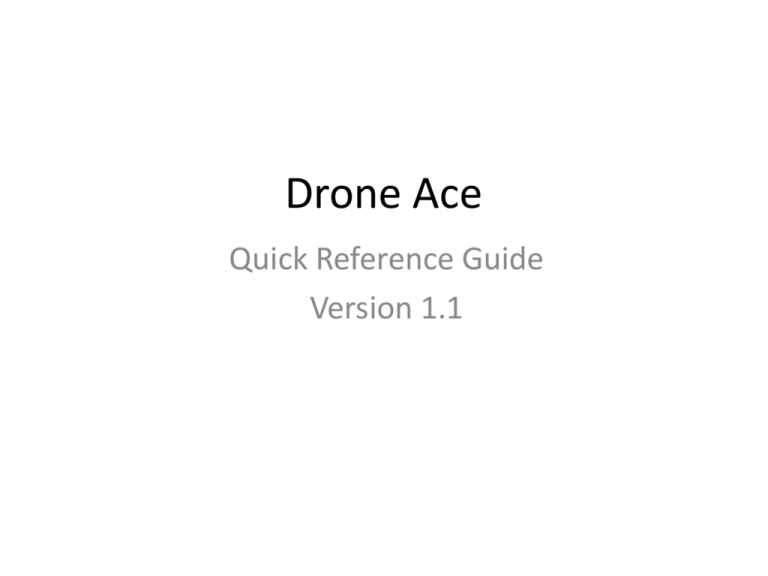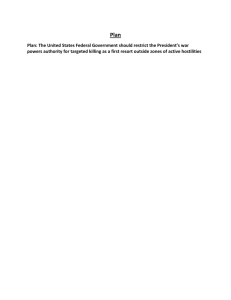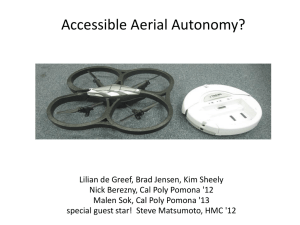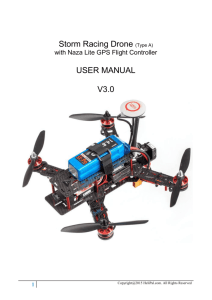Drone Ace - Drone
advertisement

Drone Ace Quick Reference Guide Version 1.1 Newest Features Simple Mode. -Simple Mode mode provides flyers with a new easy way to fly their drone. When simple mode is activated, pitch and roll controls are relative the orientation of the pilot and not the orientation of the drone. (e.g. when the drone is facing right and the user steers left, the drone will go left as opposed to away from you.) Newest Features Starting Simple Mode. -When simple mode is on, you MUST start with the drone in front of you facing away from you. This gives Drone Ace the orientation data that it needs to perform in simple mode. Newest Features (continued) Control “Toe-in” Angle -When holding the iPhone or iPad, moving the thumbs in a straight line up and down often feels unnatural. The Toe-In angle allows for user adjustable rotation of the joysticks. Normal orientation Sample increased “Toe-In” Angle Newest Features (continued) Now officially supports the Ten-One Fling analog joysticks for iPad -For users who use the iPad with fling joysticks, there is now a selectable setting for this. It moves the onscreen joysticks to the edge of the screen. It also shrinks them allowing for 100% control with the fling joysticks. More information on fling joysticks can be found here: http://tenonedesign.com/fling.php Video Recording now has 15 FPS rate. -Users can now select either adaptive or 15 FPS for framerate while recording. --Adaptive (frames are written to the video as they are received from the drone) --15 FPS (frames are written 15 times per second regardless if there is a new frame) Newest Features (continued) Adjustable audio battery level warnings. -These are in addition to the warnings sent from the drone. Simply slide the adjustable labels to where you want them. The alert sounds are frequency offset from the engine noise so that you should still be able to hear them while the drone is flying. Take off/ Land Pitch/Roll indicator Battery Level Compass (Double Tap to Flat Trim) Altitude LED Buttons (configure while landed, use while flying) Switch to Previous Camera Mode Go to in-app media browser Go To Settings (Visible when landed) Action Buttons (configure while landed, use while flying) Record Video Capture Image Emergency Engine Stop Switch to Next Camera Mode Pitch/Roll indicator Altitude Battery Level Compass (Double Tap to Flat Trim) Take off/ Land Action HUD Buttons (configure while landed, use while flying) LED HUD Buttons See Item 1 on Next Page Go to in-app media browser Go To Settings Capture Image Record Video Switch to Previous Camera Mode Switch to Next Camera Mode Emergency Engine Stop 1. 2. LED HUD Buttons – The LED HUD Buttons on the left side of the screen are configured when landing as indicated by the wrench icon. Tap the button while landed to select the LED flash pattern that you would like displayed on the AR.Drone. When the AR.Drone is flying, you can push these buttons to cause the LED Pattern you selected to show on the AR.Drone. ACTION HUD Buttons. The action HUD Buttons work the same as the LED Buttons. Configure the actions you want when on the ground. While in the air, the buttons will cause the AR.Drone to perform that action. Settings Overview Controller Mode. -Controller mode will allow you to choose between all the various control modes available in Drone Ace. The controller modes are presented graphically on the controller mode chooser screen. Standard and Standard Swapped are the most similar to the free flight app. Mode 1, 2, 3, and 4 DO NOT use the accelerometer. Two joysticks are used to control the drone. Settings Overview (continued) -Combined Yaw/Roll option --This option will cause the drone to yaw into turns much like an airplane flies. The roll command combined with forward or backward movement causes this to happen. Please expirement with different indoor/outdoor flight maximums for pitch and yaw to find a combination that you find enjoyable. The combined yaw/roll mode should only be used in an area large enough move forward quickly. -Inverted Elevation option. --Inverted elevation option causes the control stick for elevation control to invert. Now push up for down and down for up. This is similar to how real airplane is controlled. Some users are more comfortable with this style. Indoor and Outdoor maximums. -These maximums tell the drone the maximum amount of movement it is allowed to perform. Drone tilt maximums over 30 degrees can cause the drone to flip over if movement is stopped to fast. We recommend 12 degrees tilt for indoors and 20 degrees tilt for outdoors for beginners. Settings Overview (continued) If you want to go over the recommended values, please increase them slowly as you gain experience. Video settings… On firmware 1.5.1 Firmware 1.5.1 offers two settings for the video… adaptive or fixed. Adaptive mode decreases the bandwidth used by the drone for video. When signal problems occur or too many commands are being sent to the drone, the video quality will go down. This may sound like a bad thing, but it is beneficial as the control commands are typically more important than clear video. Fixed mode results in better picture quality at the risk of control commands not reaching the drone. If you are primary purpose is a video recording mission, then this may be right for you. On firmware 1.6.6 Firmware 1.6.6 introduced a new video codec called P265 in addition to the Settings Overview (continued) the existing VLIB codec. The new P264 codec is supposed to use less bandwidth than the VLIB codec, however we have noticed the video quality suffers. It is up to the user to find what they like best. In addition to the adaptive video rate previously available… the fixed rate is now adjustable. The settings screen will give you a live preview of what the video will look like at your selected settings. Drone Ace is simulating commands to the drone during the live preview so that the live preview will be similar to the actual result when flying the drone. Please remember many things can effect the video quality such as… -Distance to the drone. -Local WiFi interference caused by local networks and portable phones. Ultrasound Frequency The ultrasound frequency can be adjusted between 22.5Hz and 25Hz (default). The ultrasound is used by the drone to determine its distance from the ground so that it can automatically adjust its height. If your drone is having problems maintaining a consistant altitude, try an Settings Overview (continued) an alternate frequency. This is also useful to not use the same frequency if more than one drone is being flown in the same area. (One drone might misread the other drone’s altitude as it’s own.) Flight Area Indoor and outdoor modes are provided. These are used by the drone to determine which set of maximums settings to use. Hull Indoor hull is used when your drone is wearing the indoor hull. Out door hull is used when your drone is wearing the outdoor hull. Using the wrong hull type can lead to bad flight characteristics. Indoor Outdoor Settings Overview (continued) Altitude Limit: The limit at which the drone will try to stop climbing. This is dependent on a clean reading from the ultrasound sensors. iPhone, iPad, iPod tilt: When using “Standard” or “Standard Swapped” modes, this setting adjusts the sensitivity of the controller for pitch and roll commands. For example… if your settings are the following: • Flight area indoors • Indoor tilt max = 30 degrees • iPhone tilt max = 5 degrees Tilting the phone this much. Makes the drone tilt this much. Settings Overview (continued) For the following settings • Flight area indoors • Indoor tilt max = 10 degrees • iPhone tilt max = 45 degrees Tilting the phone this much. Makes the drone tilt this much. The iPhone, iPad, iPod tilt max has no effect on the other control methods when using Drone Ace. This is not true for other apps. Settings Overview (continued) Stalk Mode: Note stalk mode will only work after the drone starts reporting battery values. Stalk mode currently has two options. “Yaw only” or “yaw and pitch” -”Yaw only” will cause the drone to turn it’s yaw to follow the selected target. It should remain in one position turn to follow the target and also change altitude based on the target altitude. -”Yaw and Pitch” does the above and also will attempt to chase the target. It uses the distance measurement to determine at what speed to chase the target. It will try to keep the target 1 meter away at all times. Stalk What: This has the option of tapes or hulls. Depending what type of object you are trying to follow, choose tape or hull. HULL TAPE Settings Overview (continued) Stalk Color: This setting determines what color hulls or tapes you want the drone to follow in stalk mode. The options are “Orange Blue”, “Orange Green”, or “Orange Yellow”. When a stalk mode is selected. Make sure you have adequate lighting and test that the target is tracking well prior to stalking. Press the “Stalk Button” to stalk, release to stop stalking. HUD Type: The Heads Up Display (HUD) type allows the selection of the “minimal” or “Aviator” HUD as show in the images on the first two pages of this guide. Action HUD Buttons and LED HUD Buttons: The options are either “ON” or “OFF”. These buttons will be present on the HUD if you select “ON” or not on the screen if you select “OFF”. Settings Overview (continued) Video Record Mode: Video Only. Only video is recorded. Optional Data. A data overlay of drone pitch, roll, and altitude are overlaid on the video recording. Optional Audio. Audio recorded from the iPod, iPad, or iPhone is used and combined with the video. If there is no external microphone on your device, you will have to plug one in. Please note that the audio and video may not sync perfectly as the video delay during transmission cannot be predicted. Confirm Media Delete: YES = Causes a prompt for confirmation before deleting items from the In-App media library. NO = No confirmation. Reset All: Causes all settings in the app to return to their original defaults.





